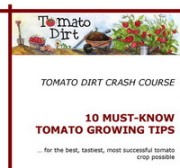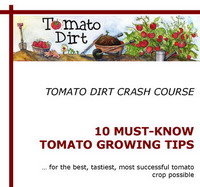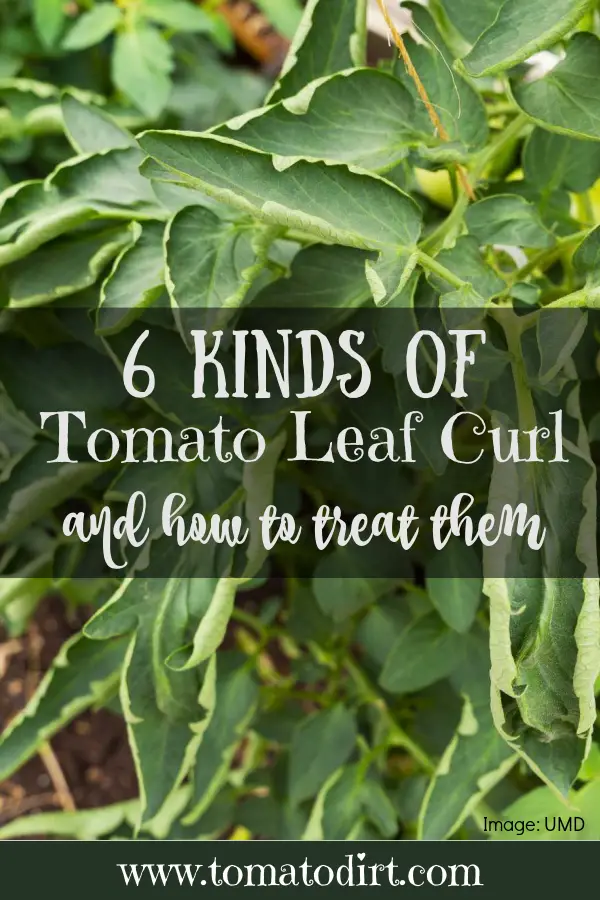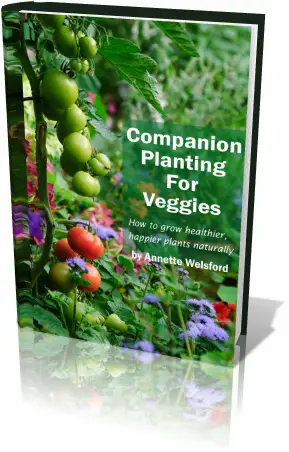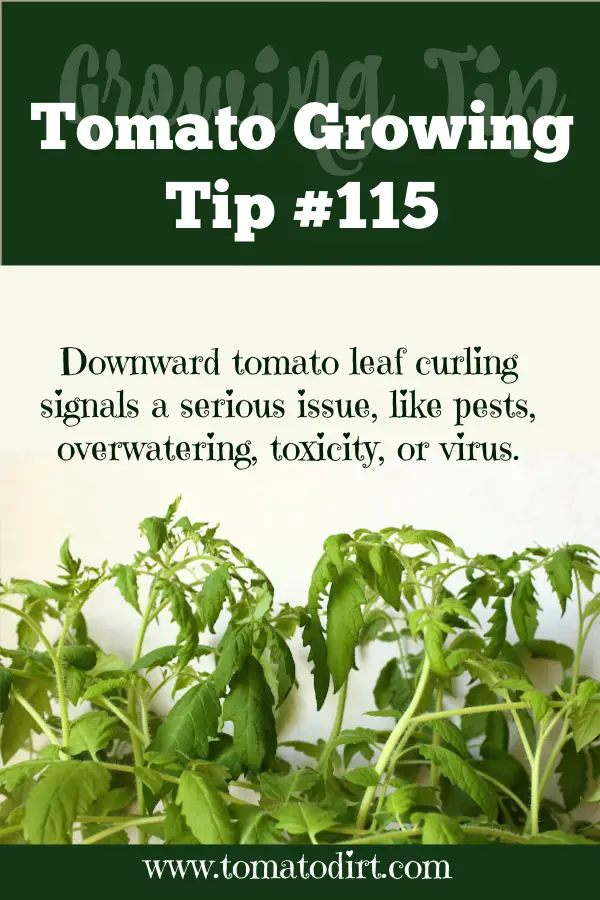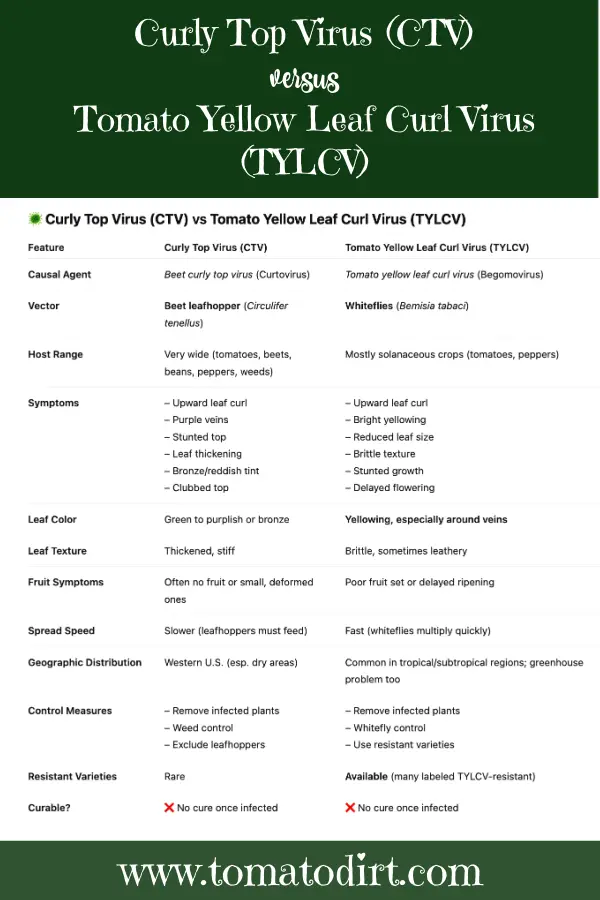FREE: 10 Must-Know Tomato Growing Tips Get The Guide
Read our affiliate disclosure here.
6 Kinds of Tomato Plant Leaf Curl
and How to Treat Them
Since 2010, Tomato Dirt has garnered 4.8+ million views, making it the web’s leading online source for growing tomatoes in the home garden. Award-winning writer and Tomato Dirt owner Kathy Widenhouse has helped thousands of home gardeners grow healthier tomatoes. Be one of them when you get Tomato Dirt’s Growing Guide here.
Posted 6.22.25
You notice that your tomato plant leaves are curling. But don’t panic just yet.
Tomato plant leaf curl is a common physiological disorder. It can manifest in several ways, depending on the underlying cause. When you see that a tomato plant’s leaves are curling, then dig a bit deeper and see what else you can find out. There are several reasons why your plants are acting this way.
And once you know what’s causing the curling, you can know what to do about it.
Why are tomato leaves curling?
There are at least 6 reasons behind tomato plant leaf curl.
1. Environmental stress
What causes this type of tomato leaf curl
- Heat stress: Prolonged high temperatures can cause leaves to curl upward to reduce water loss.
- Drought or inconsistent watering: Lack of water or irregular watering stresses the plant, leading to curled leaves.
- Wind damage: Strong, drying winds can cause leaf edges to curl to conserve moisture.
This type of tomato plant leaf curl is usually not harmful and often corrects itself when conditions improve.
Tomato leaf curl symptoms for environmental stress
- Curl direction: Leaves curl upward or inward along the edges. Older leaves at the bottom of the plant are typically affected first.
- Leaves stay green and healthy. You won’t see yellowing, spotting, mottling, or browning associated with the leaf curl – nor signs of pests or fungus. The plant still looks vigorous. New growth is usually normal and unaffected. Plant continues to flower and set fruit normally. Curling doesn’t spread rapidly or affect fruit quality.
- The weather is hot, dry, or windy. Symptoms often appear after prolonged heat (above 85–90°F), sudden drought or irregular watering, or wind exposure. Curly helps the plant reduce surface area and conserve water. If temperatures drop or watering is adjusted, leaves may flatten out again.
What you don’t see with environmental tomato plant leaf curl
- No yellowing or brittle texture (as with TYLCV)
- No distorted new growth
- No sticky residue or insects (as with whiteflies or aphids)
- No twisting or cupping that looks like herbicide damage
Tomato leaf curl treatment for environmental stress
- Check soil moisture regularly.
- Mulch to retain water and moderate soil temperature.
- Provide shade cloth during heat waves.
- Water deeply and consistently, not just shallowly.
- Avoid over-pruning during hot spells.
2. Tomato Yellow Leaf Curl Virus
(TYLCV)
What causes this type of tomato leaf curl? A virus that's spread by whiteflies.
Tomato leaf curl symptoms for TYLCV
- Leaves curl upward, turn yellow, and may become thick and brittle
- Plant growth is stunted
- Fruit production is reduced or stops
Tomato leaf curl treatment for TYLCV
- Treatment: Sorry … there is no cure. Infected plants should be removed and destroyed to prevent the spread.
Tomato leaf curl prevention for TYLCV: To prevent future plants from infection, use whitefly control. You can also plant virus-resistant tomato varieties, labeled with “TYLCV” or “TYLCV-tolerant” or part of a disease resistance code like VFFNTSWTY (where "TY" = Tomato Yellow Leaf Curl Virus)
These tomato varieties have been bred specifically to withstand or limit the effects of the virus:
Hybrids
- ‘Tygress’ – Determinate, good disease resistance, suitable for hot climates.
- ‘Shanty’ – Indeterminate, very high resistance to TYLCV, widely used commercially.
- ‘BHN 1021’ – Indeterminate, strong TYLCV and TSWV resistance.
- ‘Solar Fire’ – Heat-tolerant hybrid with moderate TYLCV resistance.
- ‘Phoenix’ – Heat- and TYLCV-resistant; good for Southern states.
- ‘Red Bounty’ – High yields and TYLCV resistance.
- ‘Grand Marshall’ – Developed for the southern U.S., shows TYLCV resistance.
- ‘Victory’ (or ‘Victory VFFF’) – Compact plant, strong disease package.
Heirlooms: While heirloom tomatoes are generally not TYLCV-resistant, some modern hybrids combine heirloom flavor with disease resistance.
- ‘Tasti-Lee’ – Crossbred for flavor and resistance (including some TYLCV protection).
- ‘Cherokee Carbon’ – A hybrid of ‘Cherokee Purple’ with increased disease resistance.
3. Herbicide damage (both drift and residue)
What causes this type of tomato leaf curl: Exposure to herbicides like 2,4-D or glyphosate, even in small amounts. If you (or a neighbor) treat your lawn with herbicide, then droplets may drift into your tomato garden.
Tomato leaf curl symptoms for herbicide damage: Twisted, cupped, or curled new growth; leaves may appear strappy or distorted. Centers of the plant may be white or yellow.
Tomato leaf curl treatment for herbicide damage: There is no specific remedy, but plants can recover if the exposure was minor. If the herbicide treatment was direct? Not so much.
Tomato leaf curl prevention for herbicide exposure: Avoid herbicide exposure and drift around tomato plants. If you plan to treat your lawn, then cover your plants. Screen compost and manure to make sure you don’t add contaminated amendments to your tomato patch.
4. Nutrient imbalance
What causes this type of tomato leaf curl: Poor soil (usually a calcium or magnesium deficiency) or inappropriate fertilizing (too much nitrogen).
Tomato leaf curl symptoms that indicate a nutrient imbalance:
- Too much nitrogen: Excess foliage, downward curl, deep green leaves.
- Calcium/magnesium deficiency: Curling, leaf distortion, blossom end rot, interveinal yellowing.
Tomato leaf curl treatment for a nutrient imbalance: Test the soil, adjust fertilizer, and apply the appropriate amendments.
Tomato leaf curl prevention for nutrient imbalances: Test your soil several weeks before the spring season to correct deficiencies. And always add compost (or other nutrient-rich organic matter) to your vegetable garden each season before planting.
5. Pests
What causes this type of tomato leaf curl: Whiteflies, aphids, and thrips. These creepy-crawlies suck sap from leaves, which can cause curling and other distortions.
Tomato leaf curl symptoms from pests: Look for sticky honeydew, visible insects, or tiny black specks (excrement) on leaves – but also stems and fruit.
Tomato leaf curl treatment from pests: Control with insecticidal soap, neem oil, or beneficial insects.
Tomato leaf curl prevention from pests: Regularly check the undersides of tomato leaves for signs of infestation and remove any affected leaves promptly. It pays to be vigilant using these methods:
- Practice companion planting. Plant garlic, onions, marigolds, or basil near your tomatoes can deter these pests.
- Use row covers. Drape your plants with lightweight, breathable row covers early in the season to physically block insects from reaching your plants.
- Encourage natural predators. Introduce beneficial insects like ladybugs, lacewings, or predatory mites that feed on these pests.
- Apply neem oil or insecticidal soap on schedule. Neem oil is an organic insecticide that can help control whiteflies, aphids, and thrips. Dilute it according to instructions and spray it on affected plants. Or, a mild soap solution (like castile soap) mixed with water can be sprayed on plants to suffocate and repel insects.
- Try using diatomaceous earth. Sprinkle food-grade diatomaceous earth around the base of plants to create a barrier that dehydrates insects.
- Monitor soil nutrients and moisture. Maintain healthy soil with proper watering and nutrient balance to keep plants strong and more resistant to pests.
- Rotate crops each season. Plant tomatoes in an area of your garden that was not home to nightshades (tomatoes, peppers, and potatoes) last year. You’ll help to disrupt pest life cycles and reduce infestation risks.
6. Genetic or Physiological Leaf
Curl
What causes this type of tomato leaf curl: Some indeterminate tomato varieties naturally curl their older leaves. If this is the cause of your tomato plant leaf curl, you’re in luck, because it is not a disease or a problem – it’s a natural trait that doesn’t impact yield or fruit quality. Predisposed plants can be triggered with excessive pruning, hot/dry weather, transplant shock, or rapid vegetative growth.
Tomato leaf curl symptoms for genetic leaf curl: Some indeterminate tomato varieties naturally curl their older leaves upward, especially in hot weather or during a period of rapid growth. If your plant exhibits no other symptoms, then you’re probably in the clear.
Tomato leaf curl treatment for genetic leaf curl: There’s no damage to plant health or yield. Yay!
Tomato leaf curl prevention for genetic leaf curl: This is one instance in which there’s nothing to worry about—this is a normal characteristic in some tomatoes. But you can prevent genetic leaf curl by limiting pruning during extreme conditions.
And prevent your own heart palpitations and worry when you avoid planting tomato varieties that are susceptible to genetic leaf curl, including:
Brandywine (Pink and Red) – Known for lush growth and sensitive foliage
Cherokee Purple – Frequently reported to show leaf curl, especially in high heat or inconsistent watering
- Sungold – A vigorous grower; often curls during fast growth spurts
- Beefsteak – Large-fruited types like this often show leaf curl due to energy demands
- Mortgage Lifter – Another heirloom with vigorous foliage growth
- Black Krim – May curl when overpruned or exposed to intense sun
- Yellow Pear – May curl when overcrowded or overfertilized
Tomato leaves curling upward indicates
…
The plant is responding to environmental stress or physiological factors. Possible causes include:
- Heat or drought stress: Leaves curl up to conserve moisture.
- Wind damage: Curling reduces exposed leaf surface.
- Over-pruning or root damage: Disrupts water uptake, leading to leaf curl.
- Herbicide exposure, especially if you see cupped, distorted, or narrow leaves.
- An indeterminate variety that’s susceptible to cupping.
- If leaves are curling up but still green and healthy-looking, and new growth appears normal, it’s usually not a serious problem.
Tomato leaves curling downward indicates …
A more serious issue affecting plant health, like...
- Pest Infestation: Aphids, whiteflies, or spider mites can cause leaves to droop or curl down as they suck sap. Look for sticky residue or visible bugs under the leaves.
- Overwatering or poor drainage: Leaves droop and curl downward from lack of oxygen in roots. They also may turn yellow or feel soft.
- Nutrient toxicity or imbalance: Too much nitrogen can lead to excess foliage growth and drooping. Potassium deficiency may cause downward curling at leaf tips or edges.
- Viral or fungal diseases: Some diseases (like Tomato Curly Top Virus) cause downward curling, leaf discoloration, stunting.
- Downward curling usually signals the plant is struggling more seriously. Get on top of it to save your tomato plant.
The top of my tomato plant is
curling. What does that indicate?
When the top of your tomato plant is curling, one possible—but serious—cause is Curly Top Virus (CTV). This is a viral disease spread by the beet leafhopper (Circulifer tenellus), and it's very different from environmental or genetic leaf curl – or even Tomato Yellow Leaf Curl Virus.
What is Curly Top Virus (CTV)?
Curly Top Virus is a plant disease caused by a Geminivirus. It infects a wide range of plants—including tomatoes, peppers, beans, and beets—by being introduced into the plant’s tissue through feeding leafhoppers.
What are the symptoms of Curly Top Virus in tomato plants?
- The plant’s top leaves curl upward, particularly the newer growth. Leaves may appear stiff, leathery, or thickened and may turn purple or yellow, particularly leaf veins.
- The entire plant growth slows or stops. Flowering may be delayed or absent. Fruit becomes small or misshapen … or the plant produces no fruit at all.
- Stems and lower leaves turn bronze or reddish.
- The top of the plant may bunch up or look distorted, sometimes called “clubbing.”
How does Curly Top Leaf Virus spread?
The virus is not soil- or seed-borne. Rather, the culprits are beet leafhoppers. They pick up the virus from infected weeds or crops and transmit it to healthy plants while feeding.
What is the treatment for Curly Top Virus?
Once infected, the plant cannot be saved. Sorry! Remove and destroy the plant to prevent the virus from spreading.
How can I prevent Curly Top Virus from affecting my tomato plants?
- Use row covers early in the season to keep out leafhoppers
- Remove weeds near your garden, especially ones like lambsquarters and pigweed, which are beet leafhopper favorites.
- Delay planting if you live in an area where CTV is common early in the season
More Tips for Tomato Problems
Help! My Tomatoes Have Green Shoulders (or Yellow Shoulders)…
Tomato sunscald: too much sun can be hazardous to tomato health ...
What causes mealy tomatoes and what to do about it ...
How to identify and treat powdery mildew on tomatoes ...
Why a tomato cracks and what to do about it ...
How to identify and control phosphorus deficiency in tomatoes ...
Why is there a hard core in tomato centers?
Blossom end rot: how to identify, treat, and prevent it ...
Get more tips on our Tomato Problems Pinterest board...
Return from 6 Kinds of Tomato Plant Leaf Curl to Tomato Dirt home
As an Amazon Associate and Rakuten Advertising affiliate I earn from qualifying purchases.
SHARE THIS PAGE:
FREE! 10 Must-Know Tomato Growing Tips: 20-page guide
Get yours here:
